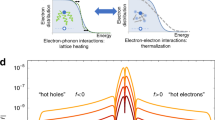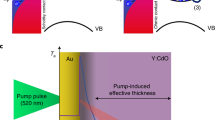Abstract
The interaction of light and matter in metallic nanosystems is mediated by the collective oscillation of surface electrons, called plasmons1. After excitation, plasmons are absorbed by the metal electrons through inter- and intraband transitions, creating a highly non-thermal distribution of electrons2,3,4. The electron population then decays through electron–electron interactions, creating a hot electron distribution within a few hundred femtoseconds, followed by a further relaxation via electron–phonon scattering on the timescale of a few picoseconds5,6,7,8. In the spectral domain, hot plasmonic electrons induce changes to the plasmonic resonance of the nanostructure by modifying the dielectric constant of the metal5,9. Here, we report on the observation of anomalously strong changes to the ultrafast temporal and spectral responses of these excited hot plasmonic electrons in hybrid metal/oxide nanostructures as a result of varying the geometry and composition of the nanostructure and the excitation wavelength. In particular, we show a large ultrafast, pulsewidth-limited contribution to the excited electron decay signal in hybrid nanostructures containing hot spots. The intensity of this contribution correlates with the efficiency of the generation of highly excited surface electrons. Using theoretical models, we attribute this effect to the generation of hot plasmonic electrons from hot spots. We then develop general principles to enhance the generation of energetic electrons through specifically designed plasmonic nanostructures that could be used in applications where hot electron generation is beneficial, such as in solar photocatalysis, photodetectors and nonlinear devices10,11,12,13,14,15,16,17,18,19.
This is a preview of subscription content, access via your institution
Access options
Subscribe to this journal
Receive 12 print issues and online access
$259.00 per year
only $21.58 per issue
Buy this article
- Purchase on Springer Link
- Instant access to full article PDF
Prices may be subject to local taxes which are calculated during checkout




Similar content being viewed by others
References
Novotny, L. & van Hulst, N. F. Antennas for light. Nature Photon. 5, 83–90 (2011).
Hartland, G. V. Optical studies of dynamics in noble metal nanostructures. Chem. Rev. 111, 3858–3887 (2011).
Voisin, C., Fatti, N. D., Christofilos, D. & Vallee, F. Ultrafast electron dynamics and optical nonlinearities in metal nanoparticles. J. Phys. Chem. B 105, 2264–2280 (2001).
Manjavacas, A., Liu, J. G., Kulkarni, V. & Nordlander, P. Plasmon-induced hot carriers in metallic nanoparticles. ACS Nano 8, 7630–7638 (2014).
Baida, H. et al. Ultrafast nonlinear optical response of a single gold nanorod near its surface plasmon resonance. Phys. Rev. Lett. 107, 057402 (2011).
Pelton, M., Liu, M., Park, S., Scherer, N. F. & Guyot-Sionnest, P. Ultrafast resonant optical scattering from single gold nanorods: large nonlinearities and plasmon saturation. Phys. Rev. B 73, 155419 (2006).
Park, S., Pelton, M., Liu, M., Guyot-Sionnest, P. & Scherer, N. F. Ultrafast resonant dynamics of surface plasmons in gold nanorods. J. Phys. Chem. C 111, 116–123 (2007).
Zavelani-Rossi, M. et al. Transient optical response of a single gold nanoantenna: the role of plasmon detuning. ACS Photon. 2, 521–529 (2015).
Inouye, H., Tanaka, K., Tanahashi, I. & Hirao, K. Ultrafast dynamics of nonequilibrium electrons in a gold nanoparticle system. Phys. Rev. B 57, 11334 (1998).
Knight, M. W., Sobhani, H., Nordlander, P. & Halas, N. J. Photodetection with active optical antennas. Science 332, 702–704 (2011).
Dani, K. M. et al. Subpicosecond optical switching with a negative index metamaterial. Nano Lett. 9, 3565–3569 (2009).
Chen, P.-Y. & Alù, A. Optical nanoantenna arrays loaded with nonlinear materials. Phys. Rev. B 82, 235405 (2010).
Mukherjee, S. et al. Hot electrons do the impossible: plasmon-induced dissociation of H2 on Au. Nano Lett. 13, 240–247 (2013).
Cushing, S. K. et al. Photocatalytic activity enhanced by plasmonic resonant energy transfer from metal to semiconductor. J. Am. Chem. Soc. 134, 15033–15041 (2012).
Abb, M., Wang, Y., de Groot, C. H. & Muskens, O. L. Hotspot-mediated ultrafast nonlinear control of multifrequency plasmonic nanoantennas. Nature Commun. 5, 4869 (2014).
Schumacher, T. et al. Nanoantenna-enhanced ultrafast nonlinear spectroscopy of a single gold nanoparticle. Nature Commun. 2, 333 (2011).
Chen, K.-P., Drachev, V. P., Borneman, J. D., Kildishev, A. V. & Shalaev, V. M. Drude relaxation rate in grained gold nanoantennas. Nano Lett. 10, 916–922 (2010).
Appavoo, K. et al. Ultrafast phase transition via catastrophic phonon collapse driven by plasmonic hot-electron injection. Nano Lett. 14, 1127–1133 (2014).
Nishijima, Y. et al. Near-infrared plasmon-assisted water oxidation. J. Phys. Chem. Lett. 3, 1248–1252 (2012).
Mühlschlegel, P., Eisler, H.-J., Martin, O. J. F., Hecht, B. & Pohl, D. W. Resonant optical antennas. Science 308, 1607–1609 (2005).
Morton, S. M., Silverstein, D. W. & Jensen, L. Theoretical studies of plasmonics using electronic structure methods. Chem. Rev. 111, 3962–3994 (2011).
Ciraci, C. et al. Probing the ultimate limits of plasmonic enhancement. Science 337, 1072–1074 (2012).
Rose, A. et al. Control of radiative processes using tunable plasmonic nanopatch antennas. Nano Lett. 14, 4797–4802 (2014).
Mertens, J. et al. Controlling sub-nm gaps in plasmonic dimers using graphene. Nano Lett. 13, 5033–5038 (2013).
Zhang, H. & Govorov, A. O. Optical generation of hot plasmonic carriers in metal nanocrystals: the effects of shape and field enhancement. J. Phys. Chem. C 118, 7606–7614 (2014).
Clavero, C. Plasmon-induced hot-electron generation at nanoparticle/metal-oxide interfaces for photovoltaic and photocatalytic devices. Nature Photon. 8, 95–103 (2014).
Tian, Y. & Tatsuma, T. Mechanisms and applications of plasmon-induced charge separation at TiO2 films loaded with gold nanoparticles. J. Am. Chem. Soc. 127, 7632–7637 (2005).
Furube, A., Du, L., Hara, K., Katoh, R. & Tachiya, M. Ultrafast plasmon-induced electron transfer from gold nanodots into TiO2 nanoparticles. J. Am. Chem. Soc. 129, 14852–14853 (2007).
Govorov, A., Zhang, H., Demir, V. & Gunko, Y. K. Photogeneration of hot plasmonic electrons with metal nanocrystals: quantum description and potential applications. Nano Today 9, 85–101 (2014).
Govorov, A. O. & Zhang, H. Kinetic density functional theory for plasmonic nanostructures: breaking of the plasmon peak in the quantum regime and generation of hot electrons. J. Phys. Chem. C 119, 6181–6194 (2015).
Palik, E. D. Handbook of Optical Constants of Solids (Academic, 1985).
Acknowledgements
This work was performed, in part, at the Center for Nanoscale Materials, a US Department of Energy, Office of Science, Office of Basic Energy Sciences User Facility under contract no. DE-AC02-06CH11357. Work by A.B.F.M. was supported by the Argonne–Northwestern Solar Energy Research (ANSER) Center, an Energy Frontier Research Center funded by the US Department of Energy, Office of Science, Office of Basic Energy Sciences under award no. DE-SC0001059. A.O.G. and L.K.K. acknowledge support from the Volkswagen Foundation and the US Army Research Office (W911NF-12-1-0407). The authors thank L. Ocola and R. Divan for their invaluable help with fabrication instruments and processes.
Author information
Authors and Affiliations
Contributions
H.H. and G.P.W. designed and carried out the experiments. L.K.K., L.V.B. and A.O.G. performed the theoretical modelling and analysis. H.H., A.B.F.M. and D.R. fabricated the samples. H.H., A.O.G. and G.P.W. interpreted the results and wrote the manuscript, with contributions from all the authors.
Corresponding authors
Ethics declarations
Competing interests
The authors declare no competing financial interests.
Supplementary information
Supplementary information
Supplementary Information (PDF 1824 kb)
Rights and permissions
About this article
Cite this article
Harutyunyan, H., Martinson, A., Rosenmann, D. et al. Anomalous ultrafast dynamics of hot plasmonic electrons in nanostructures with hot spots. Nature Nanotech 10, 770–774 (2015). https://doi.org/10.1038/nnano.2015.165
Received:
Accepted:
Published:
Issue Date:
DOI: https://doi.org/10.1038/nnano.2015.165
This article is cited by
-
Bioinspired chiral inorganic nanomaterials
Nature Reviews Bioengineering (2023)
-
Highly efficient electrocatalytic nitrogen fixation enabled by the bridging effect of Ru in plasmonic nanoparticles
Nano Research (2023)
-
Ultrafast low-pump fluence all-optical modulation based on graphene-metal hybrid metasurfaces
Light: Science & Applications (2022)
-
Experimental characterization techniques for plasmon-assisted chemistry
Nature Reviews Chemistry (2022)
-
Thermal energy dependent transient permittivity of epsilon-near-zero material
Science China Physics, Mechanics & Astronomy (2022)



